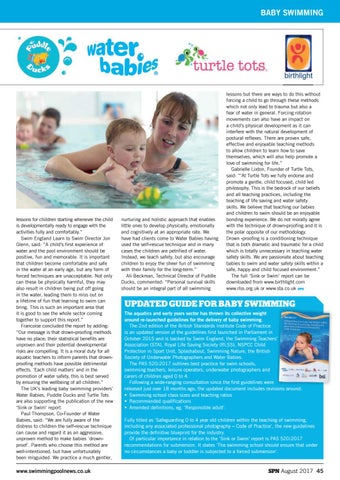BABY SWIMMING
lessons for children starting whenever the child is developmentally ready to engage with the activities fully and comfortably.” Swim England Learn to Swim Director Jon Glenn, said: “A child’s first experience of water and the pool environment should be positive, fun and memorable. It is important that children become comfortable and safe in the water at an early age, but any form of forced techniques are unacceptable. Not only can these be physically harmful, they may also result in children being put off going in the water, leading them to miss out on a lifetime of fun that learning to swim can bring. This is such an important area that it is good to see the whole sector coming together to support this report.” Francoise concluded the report by adding: “Our message is that drown-proofing methods have no place; their statistical benefits are unproven and their potential developmental risks are compelling. It is a moral duty for all aquatic teachers to inform parents that drownproofing methods have possible detrimental effects. ‘Each child matters’ and in the promotion of water safety, this is best served by ensuring the wellbeing of all children.” The UK’s leading baby swimming providers’ Water Babies, Puddle Ducks and Turtle Tots are also supporting the publication of the new ‘Sink or Swim’ report. Paul Thompson, Co-Founder of Water Babies, said: “We are fully aware of the distress to children the self-rescue technique can cause and regard it as an aggressive, unproven method to make babies ‘drownproof’. Parents who choose this method are well-intentioned, but have unfortunately been misguided. We practice a much gentler,
www.swimmingpoolnews.co.uk 44-45_SPN_Aug_17_Baby_Swimming.indd 45
nurturing and holistic approach that enables little ones to develop physically, emotionally and cognitively at an appropriate rate. We have had clients come to Water Babies having used the self-rescue technique and in many cases the children are petrified of water. Instead, we teach safety, but also encourage children to enjoy the sheer fun of swimming with their family for the long-term.” Ali Beckman, Technical Director of Puddle Ducks, commented: “Personal survival skills should be an integral part of all swimming
lessons but there are ways to do this without forcing a child to go through these methods which not only lead to trauma but also a fear of water in general. Forcing rotation movements can also have an impact on a child’s physical development as it can interfere with the natural development of postural reflexes. There are proven safe, effective and enjoyable teaching methods to allow children to learn how to save themselves, which will also help promote a love of swimming for life.” Gabrielle Lixton, Founder of Turtle Tots, said: “‘At Turtle Tots we fully endorse and promote a gentle, child focused, child led philosophy. This is the bedrock of our beliefs and all teaching practices, including the teaching of life saving and water safety skills. We believe that teaching our babies and children to swim should be an enjoyable bonding experience. We do not morally agree with the technique of drown-proofing and it is the polar opposite of our methodology. Drown -proofing is a conditioning technique that is both dramatic and traumatic for a child which is totally unnecessary in teaching water safety skills. We are passionate about teaching babies to swim and water safety skills within a safe, happy and child focused environment.” The full ‘Sink or Swim’ report can be downloaded from www.birthlight.com www.rlss.org.uk or www.sta.co.uk
UPDATED GUIDE FOR BABY SWIMMING The aquatics and early years sector has thrown its collective weight around re-launched guidelines for the delivery of baby swimming. The 2nd edition of the British Standards Institute Code of Practice is an updated version of the guidelines first launched in Parliament in October 2015 and is backed by Swim England, the Swimming Teachers’ Association (STA), Royal Life Saving Society (RLSS), NSPCC Child Protection in Sport Unit, Splashabout, Swimming Nature, the British Society of Underwater Photographers and Water Babies. The PAS 520:2017 outlines best practice for swim schools, swimming teachers, leisure operators, underwater photographers and carers of children aged 0 to 4. Following a wide-ranging consultation since the first guidelines were released just over 18 months ago, the updated document includes revisions around: • Swimming school class sizes and teaching ratios • Recommended qualifications • Amended definitions, eg. ‘Responsible adult’. Fully titled as ‘Safeguarding 0 to 4 year old children within the teaching of swimming, including any associated professional photography – Code of Practice’, the new guidelines provide the definitive blueprint for the industry. Of particular importance in relation to the ‘Sink or Swim’ report is PAS 520:2017 recommendations for submersion. It states ‘The swimming school should ensure that under no circumstances a baby or toddler is subjected to a forced submersion’.
SPN August 2017 45 25/07/2017 17:57
